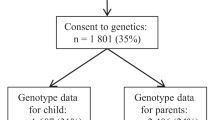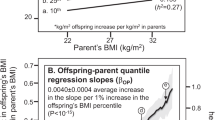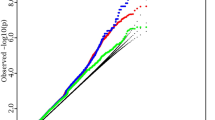Abstract
Objective:
To assess the extent that the genetic and environmental factors contribute to the phenotypic correlations between obesity traits and age at menarche (AAM), and also to examine the influence of AAM on obesity in both pre- and postmenopausal women.
Methods:
Five hundred and twelve pedigrees with 2667 Caucasian female subjects from two to four generations were recruited. Fat mass and lean mass (both in kg) were measured by dual-energy X-ray absorptiometry scanner. Body mass index (BMI) (kg/m2) was calculated. We performed bivariate quantitative genetic analyses in the total sample containing 2667 Caucasian women. We also selected 206 unrelated premenopausal women and 140 unrelated postmenopausal women from the total sample, and computed the respective phenotypic correlation between obesity and AAM in these two subgroups.
Results:
For fat mass, lean mass and BMI, we detected their significant negative genetic correlations with AAM after adjustment for significant covariates, which were −0.3170 (P<0.001), −0.1721 (P<0.05) and −0.3665 (P<0.001), respectively. However, their environmental correlations with AAM were all nonsignificant (P>0.05), ranging from −0.0016 to 0.0192. In the premenopausal subgroup, significant associations were observed between fat mass and AAM (ρ=−0.231, P<0.01) as well as between BMI and AAM (ρ=−0.257, P<0.01). In the postmenopausal subgroup, no such associations were observed.
Conclusion:
Our results for the first time suggested that significant phenotypic association between obesity phenotypes and AAM is mainly attributable to shared genetic rather than environmental factors, and AAM may have stronger effects on obesity phenotypes in pre- than in postmenopausal women.
This is a preview of subscription content, access via your institution
Access options
Subscribe to this journal
Receive 12 print issues and online access
$259.00 per year
only $21.58 per issue
Buy this article
- Purchase on Springer Link
- Instant access to full article PDF
Prices may be subject to local taxes which are calculated during checkout
Similar content being viewed by others
References
Garn SM, LaVelle M, Rosenberg KR, Hawthorne VM . Maturational timing as a factor in female fatness and obesity. Am J Clin Nutr 1986; 43: 879–883.
Power C, Lake JK, Cole TJ . Body mass index and height from childhood to adulthood in the 1958 British born cohort. Am J Clin Nutr 1997; 66: 1094–1101.
Laitinen J, Power C, Jarvelin MR . Family social class, maternal body mass index, childhood body mass index, and age at menarche as predictors of adult obesity. Am J Clin Nutr 2001; 74: 287–294.
Biro FM, McMahon RP, Striegel-Moore R, Crawford PB, Obarzanek E, Morrison JA et al. Impact of timing of pubertal maturation on growth in black and white female adolescents: the National Heart, Lung, and Blood Institute Growth and Health Study. J Pediatr 2001; 138: 636–643.
Okasha M, McCarron P, McEwen J, Smith GD . Age at menarche: secular trends and association with adult anthropometric measures. Ann Hum Biol 2001; 28: 68–78.
Wasserman L, Flatt SW, Natarajan L, Laughlin G, Matusalem M, Faerber S et al. Correlates of obesity in postmenopausal women with breast cancer: comparison of genetic, demographic, disease-related, life history and dietary factors. Int J Obes Relat Metab Disord 2004; 28: 49–56.
Samaras K, Spector TD, Nguyen TV, Baan K, Campbell LV, Kelly PJ . Independent genetic factors determine the amount and distribution of fat in women after the menopause. J Clin Endocrinol Metab 1997; 82: 781–785.
Rice T, Perusse L, Bouchard C, Rao DC . Familial aggregation of body mass index and subcutaneous fat measures in the longitudinal Quebec family study. Genet Epidemiol 1999; 16: 316–334.
Hanisch D, Dittmar M, Hohler T, Alt KW . Contribution of genetic and environmental factors to variation in body compartments – a twin study in adults. Anthropol Anz 2004; 62: 51–60.
Nguyen TV, Sambrook PN, Eisman JA . Bone loss, physical activity, and weight change in elderly women: the Dubbo Osteoporosis Epidemiology Study. J Bone Miner Res 1998; 13: 1458–1467.
Hsu FC, Lenchik L, Nicklas BJ, Lohman K, Register TC, Mychaleckyj J et al. Heritability of body composition measured by DXA in the diabetes heart study. Obes Res 2005; 13: 312–319.
Deng HW, Lai DB, Conway T, Li J, Xu FH, Davies KM et al. Characterization of genetic and lifestyle factors for determining variation in body mass index, fat mass, percentage of fat mass, and lean mass. J Clin Densitom 2001; 4: 353–361.
Doughty DJL . Behavior genetic modeling of menarche in U.S. females. In: JLRodgers et al (eds). Genetic Influences on Human Fertility and Sexuality. Kluwer Academic Publishers: Boston, 2000. pp 169–182.
Towne B, Czerwinski SA, Demerath EW, Blangero J, Roche AF, Siervogel RM . Heritability of age at menarche in girls from the Fels Longitudinal Study. Am J Phys Anthropol 2005; 128: 210–219.
Meyer JM, Eaves LJ, Heath AC, Martin NG . Estimating genetic influence on the age-at-menarche: a survival analysis approach. Am J Med Genet 2005; 39: 148–154.
Deng HW, Shen -H, Xu FH, Deng HY, Conway T, Zhang HT et al. Tests of linkage and/or association of genes for vitamin D receptor, osteocalcin, and parathyroid hormone with bone mineral density. J Bone Miner Res 2002; 17: 678–686.
Deng HW, Mahaney MC, Williams JT, Li J, Conway T, Davies KM et al. Relevance of the genes for bone mass variation to susceptibility to osteoporotic fractures and its implications to gene search for complex human diseases. Genet Epidemiol 2002; 22: 12–25.
Yang YJ, Dvornyk V, Jian WX, Xiao SM, Deng HW . Genetic and environmental correlations between bone phenotypes and anthropometric indices in Chinese. Osteoporos Int 2005; 16: 1134–1140.
Almasy L, Blangero J . Multipoint quantitative-trait linkage analysis in general pedigrees. Am J Hum Genet 1998; 62: 1198–1211.
Mayes JS, Watson GH . Direct effects of sex steroid hormones on adipose tissues and obesity. Obes Rev 2004; 5: 197–216.
Williams JT, Van Eerdewegh P, Almasy L, Blangero J . Joint multipoint linkage analysis of multivariate qualitative and quantitative traits. I. Likelihood formulation and simulation results. Am J Hum Genet 1999; 65: 1134–1147.
Lynch M, Walsh B . Genetics and analysis of quantitative traits. Sinauer Associatiates Inc.: Sunderland, MA, 1998.
Stoll BA . Western diet, early puberty, and breast cancer risk. Breast Cancer Res Treat 1998; 49: 187–193.
Ernster VL, Wrensch MR, Petrakis NL, King EB, Miike R, Murai J et al. Benign and malignant breast disease: initial study results of serum and breast fluid analyses of endogenous estrogens. J Natl Cancer Inst 1987; 79: 949–960.
Moore JW, Key TJ, Bulbrook RD, Clark GM, Allen DS, Wang DY et al. Sex hormone binding globulin and risk factors for breast cancer in a population of normal women who had never used exogenous sex hormones. Br J Cancer 1987; 56: 661–666.
Apter D, Reinila M, Vihko R . Some endocrine characteristics of early menarche, a risk factor for breast cancer, are preserved into adulthood. Int J Cancer 1989; 44: 783–787.
Haffner SM, Katz MS, Dunn JF . Increased upper body and overall adiposity is associated with decreased sex hormone binding globulin in postmenopausal women. Int J Obes Relat Metab Disord 1991; 15: 471–478.
Madigan MP, Troisi R, Potischman N, Dorgan JF, Brinton LA, Hoover RN . Serum hormone levels in relation to reproductive and lifestyle factors in postmenopausal women (United States). Cancer Causes Control 1998; 9: 199–207.
Tchernof A, Toth MJ, Poehlman ET . Sex hormone-binding globulin levels in middle-aged premenopausal women. Associations with visceral obesity and metabolic profile. Diabetes Care 1999; 22: 1875–1881.
O'Sullivan AJ, Martin A, Brown MA . Efficient fat storage in premenopausal women and in early pregnancy: a role for estrogen. J Clin Endocrinol Metab 2001; 86: 4951–4956.
Suter PM, Schutz Y, Jequier E . The effect of ethanol on fat storage in healthy subjects. N Engl J Med 1992; 326: 983–987.
Pedersen SB, Kristensen K, Hermann PA, Katzenellenbogen JA, Richelsen B . Estrogen controls lipolysis by up-regulating alpha2A-adrenergic receptors directly in human adipose tissue through the estrogen receptor alpha. Implications for the female fat distribution. J Clin Endocrinol Metab 2004; 89: 1869–1878.
Ballesteros M, Leung KC . Oestrogen inhibits activation of the JAK2/STAT5 pathway by growth hormone. Proceedings of the 11th International Congress of Endocrinology, Sydney, Australia, 2000, p 436.
Moller N, Jorgensen JO, Alberti KG, Flyvbjerg A, Schmitz O . Short-term effects of growth hormone on fuel oxidation and regional substrate metabolism in normal man. J Clin Endocrinol Metab 1990; 70: 1179–1186.
Salomon F, Cuneo RC, Hesp R, Sonksen PH . The effects of treatment with recombinant human growth hormone on body composition and metabolism in adults with growth hormone deficiency. N Engl J Med 1989; 321: 1797–1803.
Rainwater DL, Martin LJ, Comuzzie AG . Genetic control of coordinated changes in HDL and LDL size phenotypes. Arterioscler Thromb Vasc Biol 2001; 21: 1829–1833.
Deng HW, Li J, Li JL, Dowd R, Davies KM, Johnson M et al. Association of estrogen receptor-alpha genotypes with body mass index in normal healthy postmenopausal Caucasian women. J Clin Endocrinol Metab 2000; 85: 2748–2751.
Pelletier G, El Alfy M . Immunocytochemical localization of estrogen receptors alpha and beta in the human reproductive organs. J Clin Endocrinol Metab 2000; 85: 4835–4840.
Stavrou I, Zois C, Ioannidis JP, Tsatsoulis A . Association of polymorphisms of the oestrogen receptor alpha gene with the age of menarche. Hum Reprod 2002; 17: 1101–1105.
Long JR, Xu FH, Zhao LJ, Liu PY, Recker RR, Deng HW . The oestrogen receptor alpha gene is linked and/or associated with age of menarche in different ethnic groups. J Med Genet 2005; 42: 796–800.
Clement K, Vaisse C, Manning BS, Basdevant A, Guy-Grand B, Ruiz J et al. Genetic variation in the beta 3-adrenergic receptor and an increased capacity to gain weight in patients with morbid obesity. N Engl J Med 1995; 333: 352–354.
Frisch RE, Revelle R . Height and weight at menarche and a hypothesis of critical body weights and adolescent events. Science 1970; 169: 397–399.
Kurabayashi T, Carey DG, Morrison NA . The beta 3-adrenergic receptor gene Trp64Arg mutation is overrepresented in obese women. Effects on weight, BMI, abdominal fat, blood pressure, and reproductive history in an elderly Australian population. Diabetes 1996; 45: 1358–1363.
Clement K, Manning BS, Basdevant A, Strosberg AD, Guy-Grand B, Froguel P . Gender effect of the Trp64Arg mutation in the beta 3 adrenergic receptor gene on weight gain in morbid obesity. Diabetes Metab 1997; 23: 424–427.
Fujisawa T, Ikegami H, Kawaguchi Y, Ogihara T . Meta-analysis of the association of Trp64Arg polymorphism of beta 3-adrenergic receptor gene with body mass index. J Clin Endocrinol Metab 1998; 83: 2441–2444.
Marti A, Corbalan MS, Martinez-Gonzalez MA, Martinez JA . TRP64ARG polymorphism of the beta 3-adrenergic receptor gene and obesity risk: effect modification by a sedentary lifestyle. Diabetes Obes Metab 2002; 4: 428–430.
Kirchengast S, Gruber D, Sator M, Huber J . Impact of the age at menarche on adult body composition in healthy pre- and postmenopausal women. Am J Phys Anthropol 1998; 105: 9–20.
Kirchengast S . [Sex hormone concentrations and body dimensions of postmenopausal women as correlates of age at menarche]. Anthropol Anz 1993; 51: 251–265.
Ness R . Adiposity and age at menarche in Hispanic women. Am J Hum Biol 1991; 3: 41–47.
Freedman DS, Khan LK, Serdula MK, Dietz WH, Srinivasan SR, Berenson GS . The relation of menarcheal age to obesity in childhood and adulthood: the Bogalusa heart study. BMC Pediatr 2003; 3: 3.
Acknowledgements
HWD was partially supported by grants from NIH and State of Nebraska. The study also benefited from 211 State Key Research Fund to Xi'an Jiaotong University.
Author information
Authors and Affiliations
Corresponding author
Rights and permissions
About this article
Cite this article
Wang, W., Zhao, LJ., Liu, YZ. et al. Genetic and environmental correlations between obesity phenotypes and age at menarche. Int J Obes 30, 1595–1600 (2006). https://doi.org/10.1038/sj.ijo.0803322
Received:
Revised:
Accepted:
Published:
Issue Date:
DOI: https://doi.org/10.1038/sj.ijo.0803322
Keywords
This article is cited by
-
A review of menopause nomenclature
Reproductive Health (2022)
-
CPAG: software for leveraging pleiotropy in GWAS to reveal similarity between human traits links plasma fatty acids and intestinal inflammation
Genome Biology (2015)
-
Mother's age at menarche and offspring size
International Journal of Obesity (2010)
-
Meta-analysis of genome-wide association data identifies two loci influencing age at menarche
Nature Genetics (2009)



